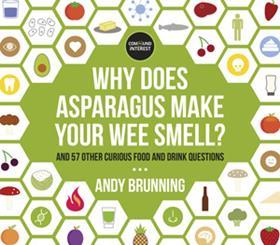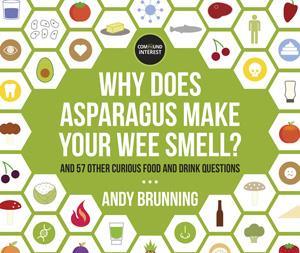Andy Brunning
Orion
2015 | 160pp | £9.09
ISBN 9781409156611

Andy Brunning leaves virtually no corner of the kitchen unexplored in this easily-digestible guide to all things edible. In Why does asparagus make your wee smell? you’ll find many a tempting morsel of information – did you ever wonder why whipping cream makes it thicker? Or why chocolate is poisonous to dogs? What is responsible for the cooling effect of mint or the pungency of wasabi? A quick flick through some of the questions tackled is guaranteed to whet your appetite.
Fans of the author’s hugely popular blog – Compound interest – will already be familiar with his infographics, which put complex information across in a way that’s visually engaging and easy to follow. The blog covers a huge range of topics, but its first book incarnation focusses solely on food. In it, each fact is presented as a question, and the colourful diagrams sit alongside short chunks of text.
The book deals with the chemistry responsible for the colours, flavours and smells of foods that will be familiar to everyone. It also delves into some of the effects they can have on our bodies. Brunning attempts to bust some common food-related myths – the widespread belief, for example, that mixing different alcoholic drinks can make a hangover worse, or that eating Chinese food can make you ill. The book even wades into age-old controversies, such as whether to keep chocolate in the fridge (which all depends on the stacking of molecules in cocoa butter, apparently).
As with the blog, the book is beautifully laid out with good diagrams and clear, concise explanations. The questions are grouped into sections such as flavour, sensation and health, although it is not designed to be read cover-to-cover and is very easy to dip in and out of. For readers less familiar with chemical structures, there is a section at the beginning explaining how to interpret them.
The book does cover a certain amount of ground that could be regarded as common knowledge. Most people – particularly the more science-savvy – will be familiar with the presence and effects of capsaicin in chillies, for example, or citric acid in lemons. At the same time, Brunning doesn’t shy away from more obscure and complex subject matter – the subtle differences in the stimulant effects of different caffeinated drinks, for instance, or how stereochemistry affects the flavours of certain compounds.
All in all, Why does asparagus make your wee smell? is an entertaining read that is pitched just about right. It is clear enough for non-specialists to follow, while for those familiar with chemical concepts it goes far enough beyond the basics to encourage further reading, should you find a topic particularly interesting. I would wholeheartedly recommend it to chemists and foodies alike.
We talk more about Why does asparagus make your wee smell? in this month’s Chemistry World book club podcast.
Next month, we’ll discuss Thing explainer by Randall Munroe. Read along with us and tweet us your thoughts using the hashtag #CWbookclub.
Purchase Why does asparagus make your wee smell? from Amazon.co.uk












No comments yet